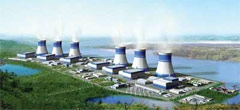China is set to begin construction of the World's first commercial modular high-temperature gas-cooled reactor. The Chinese government has commissioned the task of building the reactor to Chinergy, a joint venture of Tsinghua Holding Co. Ltd., the state-owned China Nuclear Engineering and Construction Corp. and China Guangdong Nuclear Power Group.
As the most populous nation on earth, China’s rapid growth and industrialization have fueled an urgent need for increased power generation. The Future of Nuclear Power, a study by a blue ribbon commission headed by former CIA director John Deutch, concluded that in less than 50 years, the country will need nearly as much energy output as is currently produced worldwide today. China has relied on fossil fuels and hydro power to generate nearly all of its energy, but these traditional means of creating power are becoming inadequate.
According to the World Nuclear Association, China has 11 nuclear power reactors in operation, six under construction, 15 that are about to start construction (2008 and 2009) and 18 more being planned for construction in 2010 and 2011. These plants are forecast to add 40 GW by 2020.
While coal continues to be the main energy source in China, most reserves are in the country’s north or northwest, presenting a tremendous logistical problem. Two large hydro projects are now under construction: the massive Three Gorges Dam and the Yellow River Dam. To meet demand, however, nuclear power must be added to the mix, especially in the coastal regions far from the coalfields and in communities where the economy is rapidly developing.
“As the country moves forward, nuclear power will become a vital source of electricity and will help reduce China’s dependence on coal, natural gas and oil to drive its rapid growth and modernization,” said Frank Wu, Chinergy’s CEO. Currently in China, the pressurized water reactor is the priority reactor. However, plans call for the high-temperature gas-cooled reactors (HTRs) to be used to supplement current nuclear power generation. “This will be a significant addition to the program since the HTR’s absolute quantity is remarkably large,” he said.
Wu said China’s new HTR-10 (10 MW high temperature gas-cooled reactor test module) will revolutionize nuclear power generation across the globe. China’s first 10-MW high-temperature gas-cooled reactor test module was designed and built by the Institute of Nuclear Energy Technology of Tsinghua University and began successful power generation in January 2003. This high-temperature gas-cooled reactor is highly efficient and safe, according to Wu.
Upon startup of the Shidaowan plant, China will become the first country to commercially venture into HTR nuclear technology. The plant will be owned and operated by Huaneng Group, one of China’s largest independent utilities; China Nuclear Engineering and Construction Corp., China’s construction company for the nuclear island; and Tsinghua University.
The Shidaowan project received environmental clearance in March 2008 for construction start in 2009 and commissioning by 2013. The 200 MWe (two reactor modules, each of 250 MWt) plant will drive a single steam turbine at about 40 percent thermal efficiency. The reactor module, which was originally planned for 458 MWt, was reduced to 250 MWt in order to retain the same core configuration as the prototype HTR-10.
The HTR-10 is powered by graphite balls about the size of standard billiard balls packed with tiny flecks of uranium, rather than with the conventional white-hot fuel rods used in existing nuclear reactors. Instead of water, the core is bathed in inert helium, which can reach much higher temperatures. The HTR-10 reached full power in 2003 and has an outlet temperature of 700 C to 950 C.
“First and foremost, this generator will be the safest nuclear power plant ever designed and built,” said Wu. The major safety issue regarding nuclear reactors lies in how to cool them efficiently, as they continue to produce residual heat even after shutdown. Gas-cooled reactors discharge surplus heat and don’t need additional safety systems like water-cooled reactors do. The HTR-10 was subject to a test of its intrinsic safety in September 2004 when, as an experiment, it was shut down with no cooling. Fuel temperature reached less than 1600 C and there was no failure.
“Using the existing operating HTR-10 reactor at the Institute of Nuclear and New Energy Technology of Tsinghua University in Beijing, we have already done what would be unthinkable in a conventional reactor—we switched off the helium coolant and successfully let the reactor cool down by itself,” said Wu.
Second, the modular design enables the plant to be assembled much quicker and cost-effectively than traditional nuclear generators. Its streamlined construction timetable is also a first for the nuclear power industry, where designing and building generators usually take decades, rather than years.
The modules are manufactured from standardized components that can be mass-produced, shipped by road or rail and assembled relatively quickly. The new plants are smaller and new modules can be added as needed. Multiple reactors can be linked around one or more turbines, all monitored from a single control room. The site of the Shidaowan project will install 18 additional modules, which will total 3,800 MWe.
According to Wu, the HTR-10’s design is tailor-made for the world’s fastest growing energy market. “Regions that are in the process of transforming from rural to industrial can start small, but add new modules as the area and its fuel demands grow,” he said. “We can provide them with modules one at a time, if needed. This makes start-up costs affordable and the reactors will be cheaper to operate as they grow, thanks to economies of scale in everything from staff to fuel supply.”
The nuclear reactor’s byproduct will be hydrogen, a clean fuel that provides options that are less harmful to the environment. The HTR is the only reactor that can provide a nuclear heat source to produce hydrogen, Wu said.

